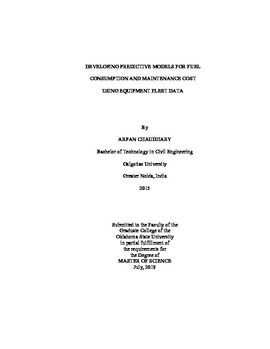| dc.contributor.advisor | Shan, Yongwei | |
| dc.contributor.author | Chaudhary, Arpan | |
| dc.date.accessioned | 2020-01-30T19:46:33Z | |
| dc.date.available | 2020-01-30T19:46:33Z | |
| dc.date.issued | 2019-07 | |
| dc.identifier.uri | https://hdl.handle.net/11244/323383 | |
| dc.description.abstract | The state departments of transportation (DOTs) possess a big construction equipment fleet that is engaged in various highway maintenance and repair activities all over the state. Fleet managers are called upon to give the budget estimates required to keep the equipment functioning throughout the year. These decisions are not easy to make as DOTs manage a big equipment fleet from pickup cabs to big size motor graders etc. This decision-making process could be improved by employing DATA MINING techniques on the equipment management data available with the DOTs. This study utilized the construction equipment data provided by the Oklahoma Department of Transportation (ODOT) and applied Multiple Linear Regression (MLR) to develop predictive models for fuel consumption and maintenance cost. The dataset was divided into two parts based on the operational charge type, i.e. equipment charged for operation by dollar/hour and equipment charged for operation by dollar/mile. In a total of the data from 2000 pieces of equipment was analyzed in this research. Four best models were selected based on the smallest average squared error (ASE) value. Apart from operational data, the model development utilized information such as equipment purchase price, age, and specified useful life of the equipment. Fuel consumption could be predicted based on yearly hours worked by the equipment or yearly miles driven. Other input variables used are current odometer value of the equipment, fuel consumption in gallons, age of the equipment, purchase price of the equipment and class code id. Maintenance cost model development used cumulative work hours and cumulative miles driven recorded in the span of the year 2011 to 2017 by Oklahoma DOT. Other input variables used are the age of the equipment, the purchase price of the equipment, current odometer value, the useful life of the equipment assigned by the manufacturer and class code ID. The coefficients of variables obtained from the MLR test are explained to see the impact on fuel consumption and maintenance cost. Finally, the model was validated by utilizing the 30% validation data and yielded good prediction results. The predictive models will help state DOTs better budget equipment operational budget as well as facilitate the equipment rental rate update process. Furthermore, future recommendations are stated at the end of the last chapter so that this study could be taken forward. | |
| dc.format | application/pdf | |
| dc.language | en_US | |
| dc.rights | Copyright is held by the author who has granted the Oklahoma State University Library the non-exclusive right to share this material in its institutional repository. Contact Digital Library Services at lib-dls@okstate.edu or 405-744-9161 for the permission policy on the use, reproduction or distribution of this material. | |
| dc.title | Developing Predictive Models for Fuel Consumption and Maintenance Cost Using Equipment Fleet Data | |
| dc.contributor.committeeMember | Banik, Gouranga | |
| dc.contributor.committeeMember | Li, Joshua | |
| osu.filename | Chaudhary_okstate_0664M_16442.pdf | |
| osu.accesstype | Open Access | |
| dc.type.genre | Thesis | |
| dc.type.material | Text | |
| dc.subject.keywords | construction equipment | |
| dc.subject.keywords | data mining | |
| dc.subject.keywords | equipment management | |
| dc.subject.keywords | fuel prediction | |
| dc.subject.keywords | maintenance cost prediction | |
| dc.subject.keywords | multiple regression analysis | |
| thesis.degree.discipline | Civil Engineering | |
| thesis.degree.grantor | Oklahoma State University | |
